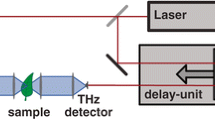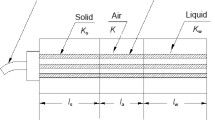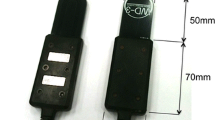Abstract
Precise measurements of the downward movement of precipitation through the unsaturated zone, as well as return flow of moisture to the atmosphere via evaporation, have always been challenging in regard to in-situ monitoring techniques. This study investigates the profile of volumetric water-content fluctuations within the unsaturated zone through a combination of field techniques, including in-situ measurements of the volumetric porewater content at different depths using specially designed time-domain reflectometry (TDR) probes. The probes are installed through direct-push vibro-coring methods, at significant depths within the unsaturated zone, providing continuous readings of the soil-moisture content throughout the unsaturated column. The measured waveform is analyzed by using the inverse modeling approach resulting in an apparent relative dielectric permittivity profile of the surrounding medium along the TDR probe length. The approach sufficiently analyzes the mechanisms of water fluxes through significant depths within the unsaturated zone, which in turn can be used to quantify groundwater recharge at areas where the unsaturated zone hydrology plays a key role in the recharge of the underlying aquifers (such as arid and hydrologically sensitive areas). The approach was applied at an experimental field site in the Upper Rhine Valley, Germany.
Résumé
La réalisation de mesures précises de l’infiltration de précipitations à travers la zone non saturée, de même que les flux de retour d’eau de l’humidité vers l’atmosphère par évaporation, a toujours constitué un véritable défi en matière de techniques de suivi in situ. Cette étude explore le profil des fluctuations de la teneur volumique en eau au sein de la zone non saturée, au travers de la combinaison de plusieurs techniques de terrain, avec notamment des mesures in-situ de la teneur volumique de l’eau interstitielle à différentes profondeurs en utilisant des sondes de réflectométrie dans le domaine du temps (TDR), spécialement conçues. Les sondes sont installées selon des méthodes de carottage assistées par vibration, à des profondeurs significatives dans la zone non saturée, permettant une lecture continue de la teneur de l’humidité du sol le long de la colonne non saturée. La forme d’onde mesurée est analysée en utilisant une approche de modélisation inverse qui se traduit par un profil de permittivité diélectrique relative apparente de l’environnement moyen le long de la sonde TDR. L’approche analyse de manière suffisante les mécanismes des flux d’eau jusqu’à des profondeurs significatives au sein de la zone non saturée, qui peuvent être utilisés pour quantifier la recharge des eaux souterraines dans des secteurs où l’hydrologie de la zone non saturée joue un rôle clef dans la recharge des aquifères sous-jacents (tels que les secteurs arides ou en situation hydrologique sensible). L’approche a été utilisée sur un site expérimental de la haute vallée du Rhin, en Allemagne.
Resumen
Las mediciones precisas del movimiento descendente de la precipitación a través de la zona no saturada, así como flujo de retorno de la humedad a la atmósfera a través de la evaporación, han sido siempre difíciles desafíos en relación a las técnicas de monitoreo in situ. Este estudio investiga el perfil de las fluctuaciones volumétricas del contenido de agua dentro de la zona no saturada a través de una combinación de técnicas de campo, incluyendo mediciones in situ del contenido volumétrico del agua poral a diferentes profundidades utilizando sondas de reflectometría especialmente diseñadas en el dominio del tiempo (TDR). Estas sondas se instalan a través de métodos de empuje directo o de extracción de sacatestigos, a profundidades significativas dentro de la zona no saturada, proporcionando lecturas continuas del contenido de humedad del suelo a través de la columna no saturada. La forma de onda medida se analizó utilizando el enfoque del modelado inverso que resultante en un perfil de permitividad aparente dieléctrica relativa del medio circundante a lo largo de la longitud de la sonda TDR. El enfoque analiza suficientemente los mecanismos de flujos de agua a través de las profundidades significativas dentro de la zona no saturada, lo cual a su vez puede ser utilizado para cuantificar la recarga de las aguas subterráneas en zonas donde la hidrología de la zona no saturada desempeña un papel clave en la recarga de los acuíferos subyacentes (tales como zonas áridas ó hidrológicamente sensibles). El enfoque se aplicó a un sitio de un campo experimental en el valle del Rin, Alemania.
摘要
降水通过非饱和带向下运移以及水分通过蒸发回流的精确测量一直是现场测量技术上的挑战。通过综合野外技术,包括采用特别设计的时域反射计探头对不同深度的容积孔隙水进行现场测量,调查了非饱和带内容积水含量波动的剖面。通过直推式震动采芯法在非饱和带内的重点深度安装探头,提供整个非饱和土柱土壤水分含量的连续读数。利用反演模拟方法分析了测量的波形,得到沿整个时域反射计探头长度周围介质明显的相对介电常数剖面。该方法充分地分析了水通量通过非饱和带内重点深度的机理,反过来,机理可以用来对非饱和带水文条件在下伏含水层(如干旱和水文上敏感区)补给中发挥关键作用的地下水补给区进行量化。该方法应用于德国莱茵河谷上游的野外试验场。.
Resumo
Medições precisas do movimento descendente da precipitação através da zona não saturada, bem como o fluxo de retorno da umidade para atmosfera por meio da evaporação, sempre foram desafiadas em detrimento à técnicas de monitoramento in-situ. Este estudo investigou a flutuação do conteúdo volumétrico de água dentro do perfil da zona não saturada através da combinação de técnicas de campo, incluído medições in-situ do conteúdo volumétrico de água intersticial em diferentes profundidades usando sondas de reflectometria no domínio do tempo (TDR) especialmente projetadas. As sondas foram instaladas através dos métodos de cravação continua (direct-push) e testemunhador por vibração (vibro-coring), em profundidades significantes dentro da zona não saturada, proporcionando leituras continuas da umidade do solo contida na coluna não saturada. A medição em forma de onda foi analisada pelo uso de aproximação por modelagem inversa resultando em um perfil aparente de permissividade dielétrica relativa do meio circundante ao longo do comprimento da sonda TDR. A abordagem analisou suficientemente o mecanismo de fluxo de água através de profundidades significantes dentro da zona não saturada, que por sua vez pode ser usada para quantificar a recarga da água subterrânea em áreas em que a hidrologia da zona não saturada desempenha um papel fundamental na recarga de aquíferos subjacentes (tal como áreas áridas e hidrologicamente sensíveis). A metodologia foi aplicada em área experimental no Alto Vale do Reno, Alemanha.













Similar content being viewed by others
References
Al-Jabri SA, Lee J, Gaur A, Horton R, Jaynes DB (2006) A dripper-TDR method for in situ determination of hydraulic conductivity and chemical transport properties of surface soils. Adv Water Resour 29:239–249
Blonquist JM Jr, Jones SB, Robinson DA (2005) Standardizing characterization of electromagnetic water content sensors: part 2, evaluation of seven sensing systems. Vadose Zone J 4:1059–1069
Coquet Y, Coutadeur C, Labat C, Vachier P, van Genuchten MT, Roger-Estrade J, Simunek J (2005) Water and solute transport in a cultivated silt loam soil: 1, field observations. Vadose Zone J 4:573–586
Dahan O, McDonald EV, Young MH (2003) Flexible time domain reflectometry probe for deep vadose zone monitoring. Vadose Zone J 2:270–275
Davis JL, Annan AP (1977) Electromagnetic detection of soil moisture: progress report 1. Can J Remote Sensing 3:76–86
Davis JL, Chudobiak J (1975) In-situ meter for measuring relative permittivity of soils. Geol Surv Canada Pap 75(1):75–79
Evett SR, Tolk JA, Howell TA (2005) Time domain reflectometry laboratory calibration in travel time: bulk electrical conductivity, and effective frequency. Vadose Zone J 4:1020–1029
Ferre TPA, Nissen HH, Simunek J (2002) The effect of the spatial sensitivity of TDR on inferring soil hydraulic properties from water content measurements made during the advance of a wetting front. Vadose Zone J 1:281–288
Gaur A, Horton R, Jaynes DB, Lee J, Al-Jabri SA (2003) Using surface time domain reflectometry measurements to estimate subsurface chemical movement. Vadose Zone J 2:539–543
Greco R (2006) Soil water content inverse profiling from single TDR waveforms. J Hydrol 317:325–339
Greco R, Guida A (2008) Field measurements of topsoil moisture profiles by vertical TDR probes. J Hydrol 348:442–451
Harlow RC, Burke EJ, Ferre TPA (2003) Measuring water content in saline sands using impulse time domain transmission techniques. Vadose Zone J 2:433–439
Heimovaara TJ, Huisman JA, Vrugt JA, Bouten W (2004) Obtaining the spatial distribution of water content along a TDR probe using the SCEM-UA Bayesian inverse modelling scheme. Vadose Zone J 3:1128–1145
Hoekstra P, Delaney A (1974) Dielectric properties of soils at UHF and microwave frequencies. J Geophys Res 79:1699–1708
Hopmans JW, Bristow KL, Simunek J (2001) Indirect estimation of soil thermal properties and water flux from heat pulse measurements: geometry and dispersion effects. Water Resour Res 38(1):7-1–7-14
Jabro JD, Evans RG, Kim Y, Iversen WM (2009) Estimating in situ soil-water retention and field water capacity in two contrasting soil textures. Irrigation Sci 27:223–229
Jones SB, Blonquist JM Jr, Robinson DA, Rasmussen VP, Or D (2005) Standardizing characterization of electromagnetic water content sensors: part 1, methodology. Vadose Zone J 4:1048–1058
Kallioras A, Piepenbrink M, Khan A, Reshid M, Rausch R, Dietrich P, Schuth C (2012) Investigation of isotopic signals in the unsaturated zone with the use of direct push technology and azaeotropic distillation. Acque Sotterranee Ital J Groundwater 2(129):019–26
Keller GV (1989) Electrical properties: section V. In: Carmichael RS (ed) CRC practical handbook of physical properties of rocks and minerals. CRC, Boca Raton, FL
Kim DJ, Choi SI, Ryszard O, Feyen J, Kim HS (2000) Determination of moisture content in a deformable soil using time domain reflectometry (TDR). Eur J Soil Sci 51:119–127
Kirkschether J (1960) Ground constant measurement using a section of balanced two wire transmission line. IRE Trans Antennas Propagation AP-8:307–312
Laloy E, Huisman JA, Jacques D (2014) High-resolution moisture profiles from full waveform probabilistic inversion of TDR signals. J Hydrol 519:2121–2135
Laurent J-P, Ruelle P, Delage L, Zairi A, Nouna B, Adjmi T (2005) Monitoring soil water content profiles with a commercial TDR system: comparative field tests and laboratory calibration. Vadose Zone J 4:1030–1036
Malicki MA, Plagge R, Roth CH (1996) Improving the calibration of dielectric TDR soil moisture determination taking into account the solid soil. Eur J Soil Sci 47:357–366
Mboh CM, Huisman JA, Vereecken H (2011) Feasibility of sequential and coupled inversion of time domain reflectometry data to infer soil hydraulic parameters under falling head infiltration. Vadose Zone J 75:775–786
Murdoch LC, Slack WW, Harrar W, Siegrist RL (2000) Embedded sidewall samplers and sensors to monitor the subsurface. Ground Water 38(5):657–664
Noborio K, Kachanoski RG, Tan CS (2006) Solute transport measurement under transient field conditions using time domain reflectometry. Vadose Zone J 5:412–418
Nussberger M, Benedickter H, Baechtold W, Fluehler H, Wunderli H (2005) Single-rod probes for time domain reflectometry: sensitivity and calibration. Vadose Zone J 4:551–557
Oswald B, Benedickter HR, Baechtold W, Fluehler H (2004) A single-rod probe for time domain reflectometry measurements of the water content. Vadose Zone J 3:1152–1159
Oswald B, Benedickter HR, Bächtold W, Flühler H (2003) Spatially resolved water content profiles from inverted time domain reflectometry signals. Water Resour Res 39(12):1357
Perdok UD, Kroesbergen B, Hilhorst MA (1996) Influence of gravimetric water content and bulk density on the dielectric properties of soil. Eur J Soil Sci 47:367–371
Pfletschinger H, Engelhardt I, Piepenbrink M, Koeniger F, Schuhmann R, Kallioras A, Schuth C (2012) Soil column experiments to quantify vadose zone water fluxes in arid settings. Environ Earth Sci 65(5):1523–1533
Plauborg F, Iversen BV, Laerke PE (2005) In situ comparison of three dielectric soil moisture sensors in drip irrigated sandy soils. Vadose Zone J 4:1037–1047
Robinson DA (2004) Measurement of the solid dielectric permittivity of clay minerals and granular samples using a time domain reflectometry immersion method. Vadose Zone J 3:705–713
Robinson DA, Jones SB, Wraith JM, Or D, Friedman SP (2003) A review of advances in dielectric and electrical conductivity measurement in soils using time domain reflectometry. Vadose Zone J 2:444–475
Robinson DA, Friedman SP (2003) A method for measuring the solid particle permittivity or electrical conductivity of rocks, sediments, and granular materials. J Geophys Res B 108(B2):5:1–9
Scheuermann A, Huebner C, Schlaeger S, Wagner N, Becker R, Bieberstein A (2009) Spatial time domain reflectometry and its application for the measurement of water content distributions along flat ribbon cables in a full-scale levee model. Water Resour Res 45:W00D24
Schlaeger S (2005) A fast TDR-inversion technique for the reconstruction of spatial soil moisture content. Hydrol Earth Syst Sci 9:481–492
Schmitz M, Sourell H (2000) Variability in soil moisture measurements. Irrigation Sci 19:147–151
Schwartz BF, Schreiber ME, Pooler PS, Rimstidt JD (2008) Calibrating access-tube time domain reflectometry soil water measurements in deep heterogeneous soils. Soil Sci Soc Am J 72(4):917–930
Souza CF, Matsura EE (2003) Multi-wire time domain reflectometry (TDR) probe with electrical impedance discontinuities for measuring water content distribution. Agric Water Manag 59:205–216
Stacheder M, Koeniger F, Schuhmann R (2009) New dielectric sensors and sensing techniques for soil and snow moisture measurements. Sensors 9:2951–2967
Todoroff P, Lan Sun Luk J-D (2001) Calculation of in situ water content profiles from TDR signal traces. Meas Sci Technol 12:27–36
Topp GC (2003) State of the art of measuring soil water content. Hydrol Process 17:2993–2996
Topp GC, Les Davis J, Annan AP (2003) The early development of TDR for soil measurements. Vadose Zone J 2:492–499
Topp GC, Davis JL, Annan AP (1980) Electromagnetic determination of soil water content: measurements in coaxial transmission. Water Resour Res 16:574–582
West LJ, Truss SW (2006) Borehole time domain reflectometry in layered sandstone: impact of measurement technique on vadose zone process identification. J Hydrol 319:143–162
Whalley WR (1993) Considerations on the use of time-domain reflectometry (TDR) for measuring soil water content. Eur J Soil Sci 44:1–9
Wyseure GCL, Mojid MA, Malik MA (1997) Measurement of volumetric water content by TDR in saline soils. Eur J Soil Sci 48(2):347–354
Acknowledgements
The authors would like to acknowledge the cooperation between Technical University of Darmstadt (Germany), Helmholtz-Centre for Environmental Research-UFZ (Leipzig, Germany), GTZ-IS (Riyadh Offices, Saudi Arabia) and the Ministry of Water and Electricity-MoWE, Kingdom of Saudi Arabia. The work was conducted within the framework of the BMBF funded research program IWAS (http://www.iwas-sachsen.ufz.de/).
Author information
Authors and Affiliations
Corresponding author
Rights and permissions
About this article
Cite this article
Kallioras, A., Khan, A., Piepenbrink, M. et al. Time-domain reflectometry probing systems for the monitoring of hydrological processes in the unsaturated zone. Hydrogeol J 24, 1297–1309 (2016). https://doi.org/10.1007/s10040-016-1421-z
Received:
Accepted:
Published:
Issue Date:
DOI: https://doi.org/10.1007/s10040-016-1421-z




